
Herschel Roman and 50 Years of Genetics at The University of Washington
Presented to the Genetics department seminar by David Stadler on 14 December, 1992.

The reason that I decided to give this seminar is to celebrate an anniversary. It turns out that this fall is the 50th anniversary of when Herschel Roman came to the faculty of the University of Washington. 1942. In a sense, that's when Genetics really started here at the University. I felt this was an important occasion to be marked, especially for those of you who have come here in the last three and a half years since Hersch died and never did meet him. I thought it should be of interest to you to hear something about his time here and his impact on this University and on the Genetics program. So that is what I'm aiming to do today.
Herschel Roman was born in eastern Poland in 1914. He was seven years old when his family moved to the United States and settled in Minnesota. After a few years, they moved to St. Louis. He went to high school in St. Louis and then he went to the University of Missouri and graduated there in 1936. He then stayed on for graduate work. He had studied chemistry and physics while he was an undergraduate and intended to do graduate work in one of those fields. But he got started working with a physics professor who was working with L. J. Stadler, a maize geneticist, on a study of ultraviolet-induced mutation in maize. The physicist was setting up apparatus so they could look at the spectrum of mutation at different wavelengths of UV light. Hersch got interested in the other side of the project, the corn genetics, and decided to do his graduate work in genetics with Stadler. And so he did, and got his Ph.D. degree in 1942.
This is a picture that was taken in the cornfield at Missouri of Roman and L.J. Stadler.

In the meantime Roman had gotten married. (Caryl Roman is here today.) Both Caryl and I knew Hersch for an awfully long time. Their older daughter, Linda, was born a year before he finished his Ph.D. As he was finishing his graduate work, he arranged to go to CalTech and had gotten a one year postdoctoral fellowship .
Meantime, at the University of Washington, the Botany Department had a geneticist named Herbert Riley, who had been here for a few years and was leaving. He had been offered a job at the University of Kentucky and was going to take it. So, the chairman of Botany sent out a letter to the handful of plant geneticists he knew of around the country to ask them if they knew of any young man who would be available for this position. The letter was sent to L. J. Stadler at Missouri. He immediately thought of it as a possibility for Roman and talked to him. Roman was interested, so Stadler wrote back recommending Roman.
Negotiations proceeded and they hired him to come that fall. For the young Roman family, an academic job was preferable to a postdoctoral fellowship, perhaps because it promised more security in an uncertain future. America was in the war now, and Hersch faced the prospect of military service. I gather from the correspondence which I read up in the UW archives that L. J. Stadler felt the same way, that this was something he should certainly do if he had the opportunity. I remember there was one point in the negotiations...I think almost everything was settled...and then Dr. Rigg, the Botany chairman, wrote to Roman to say that unfortunately he had talked to the dean and it turned out that his previous promise that they could pay him 3600 dollars a year was not quite right and that in fact, because the summer salary didn't work out the way he had planned, it was only going to be 3200, and he hoped that this wouldn't prevent Roman from being interested. Apparently Roman wrote right back and said "I'm still interested."
Everything went ahead as planned. The Romans, Herschel and Caryl and their one-year old daughter, Linda, arrived in Seattle in September of 1942. I remember (I was finishing high school at the time) that Hersch hired me at a miserably low wage--less than 3200 a year--to harvest his corn for him, because the ears were not going to be ready until after he left.
Hersch was only here (Seattle) a little over a year before he joined the Army Air Force as an officer. He served about two years, in Florida and in Texas, I believe. And then after the war he came back and was eager to get back to his maize plants and his teaching .
I should say that during those first years that Hersch was
here, Leo Hitchcock, who was the new chairman of Botany

So, he came back from the army and went back to growing corn. The thing that Roman was working on was the B chromosomes in maize. Now the B chromosomes are the supernumerary chromosomes that don't have to be there but are present in some strains. All maize plants have ten pairs of regular chromosomes that are essential. All the known genes and mutations are on those chromosomes, but some wild strains of corn have up to eight of these extra B chromosomes and Roman studied those and studied their segregation and learned some things about the mechanisms that caused them to persist even though they didn't have any apparent selective value. He found that there was a regular nondisjunction in the male parent in the mitotic divisions after meiosis which gave, instead of one copy of a B chromosome, two copies to one of the products, and that product usually became the germ nucleus(the male nucleus for the zygote). So this was a mechanism which enhanced the numbers and worked against the loss of the B chromosomes. But Roman found out in those first years after the war that there was a problem about doing maize genetics in Seattle. The problem was that it wouldn't grow here. These strains of indian corn that they grew were not very hardy and needed a lot of warm, sunny weather. Look again at the picture in the cornfield at Missouri. You can see how miserable those corn plants are. That's the kind ot thing they dealt with...those are the interesting corn plants, the ones that have all the interesting genes. And so it's not surprising with Seattle's climate that you couldn't count on corn of that kind to mature. Effectively, you couldn't do corn genetics west of the Cascades...outdoors.
So that left them with three alternatives, and Roman tried all three. One was to grow the corn in the greenhouse, and he did that but there was not very much greenhouse space, not enough certainly to keep up experiments at the rate he wanted to do them. Second was to go to CalTech in the summer and grow corn in Pasadena. There was a maize geneticist at CalTech. Roman wrote and was invited to come there, and spent three summers, 1946, '47 and '48, growing corn in Pasadena. I think he enjoyed that a lot in some ways, but he decided he couldn't go on doing that forever, transfering everything down there at the beginning of the summer and coming back the end of each summer. So in 1949 he tried the third alternative which was to go to Cle Elum...go east of the mountains where the University had rented a plot... and grow corn over there. That was rather primitive conditions for this city boy, I think. I don't know if he was actually camping out during the pollinating season, but at least it was not a comfortable and efficient way to grow corn, according to Roman's preferences. So growing corn up here turned out to be a pretty difficult thing.
Let's see, I have a couple more pictures here. This is
Roman in the
Air Force.

This is at CalTech, I believe,

And this one is in the Botany greenhouse.

Well, anyway, after considering all those alternatives, Roman finally chose the fourth solution, which was to quit maize genetics and work with something else. Already in 1947 he had learned something about the genetics of microorganisms that was getting started,and he had heard about the yeast genetics which had been started by Carl Lindegren at Washington University in St. Louis. Roman's colleague, Howard Douglas, in the Microbiology Department was already working with yeast, doing physiology and biochemistry studies of fermentation of particular sugars in yeast.
Roman and Douglas together decided they'd like to learn more about yeast genetics, so they arranged for the University to invite Lindegren to come here as a Walker-Ames professor and give some lectures on his yeast genetics. That was in 1947. Lindegren came and gave his lectures and stayed a couple of weeks and told Roman and Douglas about his methods of doing yeast genetics. They decided to go ahead and push forward on this. But they didn't do it very fast, because it was 1949 when they finally got a small grant which bought a micromanipulator with which to do yeast tetrad dissections. They hired a student to do the work, and this was Don Hawthorne. Don was still an undergraduate, close to graduation, when at the end of 1949 he was brought in and introduced to the micromanipulator. Fortunately, Don has recently written some memoirs about those days for a new book about the history of yeast genetics, and he let me have a copy of his paper, so I'll just read a paragraph of it about that time.
He says, "...It was December of 1949 when I was given a transcript of Lindegren's lectures, a micromanipulator still in its packing case, and two haploid yeast strains, 933B α f g (α is mating type, f is flocculence and g is galactose fermentation) and 931C a F G. In the week or so before the Christmas holidays I read the transcript, set up the de Fonbrune micromanipulator in a little room hidden behind the herbarium, had a dissection chamber made up to my specifications, and prepared the special media: Lindegren's presporulation medium, gypsum slants and galactose fermentation tubes with gas traps. I was told by Roman and Douglas to cross the haploid stocks, sporulate the diploids, dissect some asci, score the spore clones, and see if I could find a tetrad with a case of gene conversion."
So, he did that, and I think he did it all during the Christmas holidays, before Roman and Douglas came back to work. Anyway, that was the beginning of yeast genetics at the University of Washington, and Hawthorne as you can see was a central figure. He graduated the next June, and the yeast program suffered a jolt then. Hawthorne was going to stay on for graduate work, but the Korean War intervened. He was sent off to Korea (or maybe it was Okinawa). Things went on at a slower pace here until he returned, a year later, then picked up again.
The yeast genetics was started then, and Roman and Douglas and Hawthorne and several other people who learned the procedures pursued it. Now, one of the first things they studied was this gene conversion. Lindegren had reported that he got other than 2:2 segregations for segregating genes in crosses, so this was what they set out to study. What Don found was that he did get ratios other than 2:2, but not just for a particular gene pair, but for three pairs at once. He and his two mentors concluded that this was based on polyploidy, that they had tetraploids rather than diploids going through meiosis. They published their first yeast paper on this work showing polyploidy as a source of non-2:2 ratios in yeast. Lindegren later showed that, even so, even in strains where he really did have haploid parents, he still got occaisional 3:1 and 1:3 segregations. So this process could occur even in the absence of polyploidy. He named it "gene conversion". This was a subject that was of interest to Roman throughout his career.
Roman started working about 1955 on the adenine mutants in yeast. There was a mutant that made red colonies, in fact there were two loci known for the red adenine genes, ade1 and ade2. Mutation of either of these loci resulted in requirement for adenine along with red pigment being present in the colonies. Roman observed that when he cultured this red adenine mutant and just kept it in culture in rich medium and then plated out cells to get colonies, that he regularly got a few white colonies. Mutation going from red to white. He showed by genetic analysis that these were not back-mutation of the red, but actual new mutation at a second locus, another locus which controlled adenine requirement at an earlier step in the pathway. I think we've got a picture here of some colonies. So, as you can see, those things would leap to the eye. Roman would pick up the white ones and then by building diploids and making crosses he could show that he now had a double mutant. The red adenine mutant was still present, but a second mutation was also present.
So in this way he was able to pick up about a hundred new mutations for adenine requirement which turned out (when he analyzed them by complementation) to represent five new loci. So that meant that he had a large number of mutants at each of these loci. He found he could tell whether two mutations at the same locus were different from each other by a recombination test. He had built a diploid of two mutants, and he knew they were at the same locus, because the diploid required adenine. In the case that they were different mutations at different sites, he found that if he plated out a drop of that culture on medium without adenine, a few colonies would come up. Whereas, if he had a diploid where both components had the identical mutant, no colonies would come up. So this was a very simple test which showed the two mutants were different from each other. Showed what he called heteroalleles.
Now this was a very thrilling finding for Roman. He was getting at details of genetic analysis which were very interesting and which in the material he had worked on before (maize) would have been extremely difficult. He did the heteroallele test by spreading a drop and incubating overnight and looking the next day; to do that with maize would have involved a season's growth, a large plot of plants and a lot of work. Roman very quickly became inspired by the power and simplicity of the yeast analysis and became a great protagonist for experiments of this kind.
He had a quarrel with Lindegren about gene conversion. "Gene conversion" was Lindegren's term and Lindegren believed gene conversion was actually a mutational process. He felt that the presence of the two different alleles in the heterozygous diploid caused some kind of an instability that resulted in a mutation, and that the conversion was the result of a new mutation. Roman did an experiment which showed clearly that that was not the case. In the adenine system he analyzed a gene conversion ascus: it had three mutants and one wildtype. All three mutants by his allele test were identical to the mutant in the haploid parent for the cross. So it was a third copy of the same mutant, and not a new mutation. Roman thought that the term gene conversion was tied to Lindegren's interpretation, and for that reason shouldn't be used. He proposed "inter-allelic recombination", which unfortunately wasn't as catchy a title as gene conversion. Even though Roman was right about the science, gene conversion was the name that caught on and was used by everybody later on, even by Roman himself. He continued to study the properties of this recombination event throughout his career.
In the early fifties Roman took a sabbatical and worked in Paris with Boris Ephrussi. Ephrussi was the discoverer of the petite strains of yeast which showed cytoplasmic inheritence. That's a material which has continued to be studied extensively in that laboratory ever since. Roman enjoyed this visit a great deal. He loved working in Paris and working with Ephrussi, who was very sophisticated and cosmopolitan and witty. Life in Paris suited not just Hersch, but all the Romans.
This is Hersch and Caryl and their daughter Linda.

In any case, he stuck with yeast. They only stayed home three years before going back to Paris in 1956 for another sabbatical year. Meanwhile, back at the UW, science was quiet and passive. Herschel Roman was getting restless. In the late fifties, he was discouraged with what he considered the slow pace of science here. He felt that UW biology was not taking sufficient part in the active things that were going on, especially in genetics. He had seen so much of it in his visits to CalTech and other places around the country and to Paris. He was anxious that the UW play a greater part in that. He was instrumental in getting the administration to appoint a biology committee, a faculty committee to discuss the future of biology here and to make recommendations.
The committee recommended that biology in the College of Arts and Sciences be restructured. In effect, biology at that time was the Botany and Zoology departments, both in Johnson Hall. I think the committee recommended that there be a Biology Department, but that it be divided into sections which would reflect more modern areas of biology, like genetics, as separate sections. This proposal was not accepted. Apparently it was opposed by people in Botany and Zoology and so it was never adopted. But the administration (and, indeed, the faculties of Botany and Zoology) felt it important to keep Roman, so they agreed to set up a Genetics Department.
So in 1959 the Genetics Department was formed, with Herschel Roman as chairman. It was a very small department. Let me tell you about the search committee. It was the middle of June, 1959, and the following Monday the Board of Regents was scheduled to meet and approve the formation of the new Department of Genetics with Herschel Roman as chairman. But on the preceding Thursday it was pointed out by somebody that there was a rule in the Faculty Code, or the University rules, that a chairman cannot be appointed until there has been a search by a duly delegated search committee. So, the dean of Arts and Sciences hastily gathered together a search committee which was made up of me and Howard Douglas and Leo Hitchcock. We were called into session very abruptly in a little room over in the Administration Building and told to start searching. We looked around for a few minutes and then decided to take a vote. Roman was actually selected, although he was not the unanimous choice. There was one vote for Gregor Mendel. Not mine...it could have been either of the other two.
Anyway, the department was set up. The department, at that
time, included Roman and Hawthorne and myself, who were in
residence in the department. And it included three joint
appointment people who were in other departments. One was Howard
Douglas in Microbiology. The other two were the Medical
Geneticists, because in the meantime a Medical Genetics unit had
been formed by the Department of Medicine quite independently of
the genetics in the arts college. This is the young Arno Motulsky
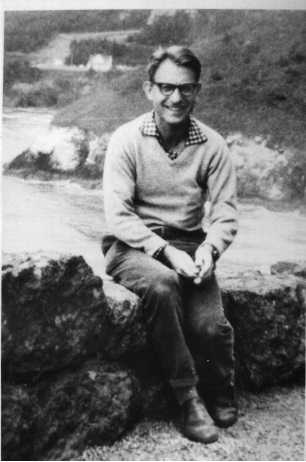
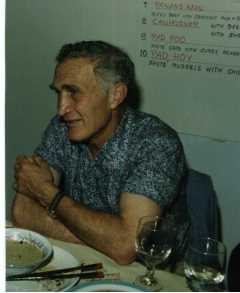
So Gartler came in '57, and the Genetics Department started two years later with three regular faculty members and three joint appointment members. That was the start, but Roman again became impatient with the pace of events. In 1961, he was the chairman of Genetics, but he didn't have very much of a department. He did have permission to make a couple of appointments. And, in fact, in 1961 we were already negotiating with Jon Gallant, who was at that time a 24-year-old grad student at Johns Hopkins, just about to finish his degree. He came out to visit and was hired and was set to come in the fall. (Jon tells me there are no pictures of him from that time and so I haven't been able to get one. Same for Don Hawthorne...I tried to get a picture of him at the micromanipulator with Roman and Douglas looking over his shoulder, but there's no picture of that either, so he told me.)
Anyway, Hersch was anxious to have something more in this Genetics Department. He felt that we needed a bigger group and we needed better space if we were going to have a Ph.D. program that would really attract people to come here. Our faculty group was too small. The space we had was sort of a corner of the third floor of Johnson Hall. We were still in the space we had been in when we were in the Botany Department up to 1959, and there was not much room for expansion there. Roman was disappointed in the Administration for not encouraging the development of Genetics more. They apparently just called it a department to placate him but had not really come through with the things which would make it an effective working group.
In 1961 at CalTech they were looking for a new chairman for the Division of Biology. George Beadle had resigned and gone to the University of Chicago as president. CalTech had a temporary chairman, Ray Owen, who was already there. However, he was not going to be permanent chairman. Several of the Caltech faculty (Owen and Sturtevant and Horowitz) apparently thought Roman would be an ideal new chairman, and so they spoke to their colleagues and then he was offered the job. This was apparently a very attractive offer and one that he considered very seriously for some months, and finally turned down and decided he would prefer to stay here. In the course of making that decision he talked with people in the Administration about the development of Genetics here. Arrangements were made to overcome some of the problems both for size of the staff and for space. Ray Owen tells me that he feels he's responsible for the development of Genetics at the University of Washington because he was the one who thought of the idea of inviting Roman to CalTech. In some sense, I guess that's true.
The space problem was overcome when Roman and Hans Neurath of Biochemistry were encouraged to go ahead and make an application to the NIH for building funds to build this wing, the J wing. This new wing of the Health Sciences Building would be for Biochemistry and Genetics. The project succeeded and resulted in this building being opened in 1965. That's when we moved into this space. Also, the size of the Genetics faculty was increased through the sixties to ten regular members.
This was the original department, the people who were here at the start. Jon Gallant was already coming in '61. Larry Sandler came in '62. Sandler came from the University of Wisconsin. He came in '61 to teach our summer course, and then in '62 he came back and taught it again and never left. By then the arrangements had been made to hire him. Ben Hall, '63; Gus Doermann, '64; Walt Fangman, '67; and Joe Felsenstein and Lee Hartwell both the next year; Breck Byers in 1970. By that time, the size of the department was almost what it is now. The graduate student population had been increased to almost the size that it is now, over thirty grad students by the end of the sixties.
In 1965 we moved into the first two floors of the newly-
constructed J-wing. Here is a picture of
Herschel Roman with me at a little dedication ceremony

I want to say something about a couple of people who died and
so aren't here for you to see in the flesh. This picture shows
Gus Doermann with his favorite organism
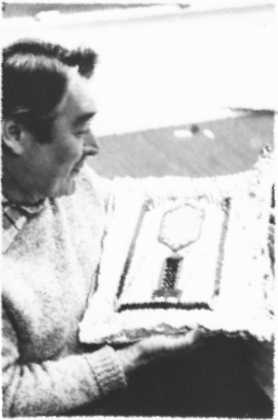
This is Larry Sandler about the time he came here.
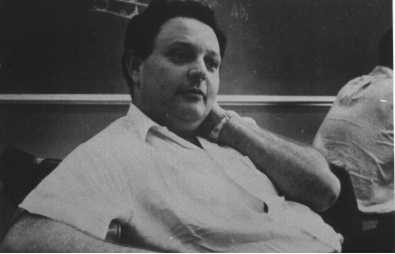
Back to Herschel Roman. Once the department was well
started, Roman was especially interested in the Ph.D. program. He
continued to do research and had a research lab to the end of his life,
doing studies on recombination and gene conversion in yeast, but he
was especially interested in developing the Ph.D. program and the
graduate students. This shows Roman with a couple of his early students,
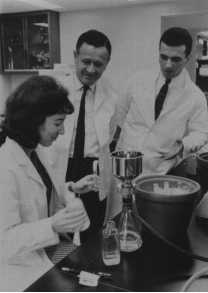
Roman took part in a lot of boards and committees and travelled a
lot. That was very useful, I think. This is a picture of him with
Alexander Hollaender,
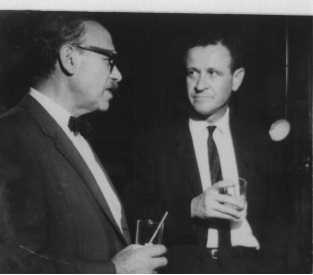
In 1965 Roman was asked to start the Annual Review of
Genetics. He became the first editor, and he was the editor for
twenty years, and Sandler was the associate editor. There's a picture
of the two editors.
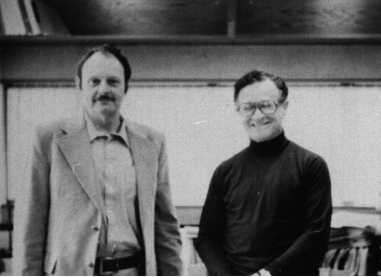
Another thing I wanted to say something about was Roman as the "father of yeast genetics". I think he was the real father. Even though Lindegren was the first yeast geneticist in America (and Winge in Denmark did a little yeast genetics before that). Roman was really the father of yeast genetics because to be a father you have to beget and he begat all these yeast geneticists. Lindegren was more of a solitary one. He and his wife worked together and with a small group, but didn't pass on their work to many students or colleagues. Whereas Roman was so intrigued with it that he was always showing someone else what a wonderful thing it was and getting them interested.
That's why we have this picture of Sy Fogel.
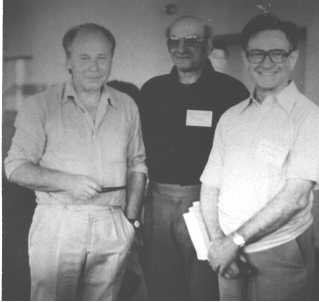
Another evidence of the effectiveness of his missionary zeal is the yeast group here. It's well known that in this department there's a very big yeast group, but it's important to remember that this group was not purchased; it was seduced. Three of the biggest yeast labs here are run by people who were not working with yeast when they came, but who, after being here, switched to yeast. That's Walt Fangman, Ben Hall and Breck Byers; all people who were entranced by the opportunities of working with yeast and switched material.
In 1970 Roman was elected to the National Academy of Sciences. He was the second member from the University; before that there was only Hans Neurath of Biochemistry. I think they were the only two in the state at the time. Since then there have been four more members of the National Academy from the Genetics Department: Doermann, Arno Motulsky, Lee Hartwell and Stan Gartler have all been elected to the Academy.
In August of 1980 there was a big celebration held for
Herschel Roman here. He was 65 and he was retiring as chairman of
Genetics and so a huge party was held--a scientific party, at which
people who had been in the department as grad students or
postdoctroral fellows were invited to come back and take part.
People came from all over the world . There was a two-day
scientific symposium of reports, mostly by people who had been
graduate students in the department. There was a banquet at which
Howard Douglas gave a very nice introduction and Herschel Roman
himself gave a talk about his experiments on gene conversion.
Here are two pictures from that occasion.
The first one is all the people who attended
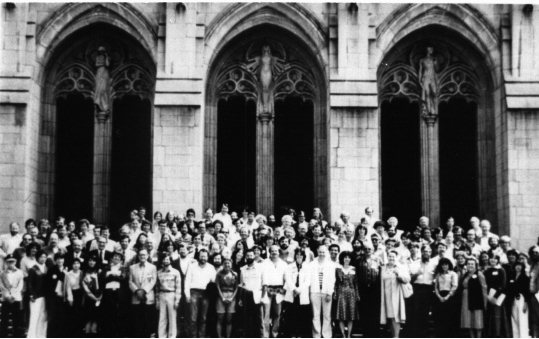
There were many bright days for the Genetics Department, and there were a couple of very dark days. One was in January of 1976 when Herschel Roman suffered a severe stroke. He was 61 then, and the stroke left him with his right side paralyzed. He lost the use of his right hand, and was unable to work at the bench anymore after that. This was a devastating thing. He was a proud man who had been a graceful athlete when he was younger, and so it must have been a very hard thing for him to take. He recovered from the stroke and rebuilt his life. This was very impressive to those of us who knew him. And so he continued to live a full and meaningful life for the thirteen years after that.
The other very dark day was in 1987 when Larry Sandler died suddenly of a heart attack. He was 57 and this happened so unexpectedly and suddenly that it was a great shock to everyone, of course. It made us all realize how central he was to everything we were doing in the Department.
Herschel Roman himself died in July of 1989, and he was active right up to the end of his life. He received an honorary degree from the University of Missouri just a couple of months before he died. This was something that was a great satisfaction to him and he enjoyed a great deal. His last paper was published after he died, and he was still working on it up to a few days before his death. So he had an active life right to the end.
I want to mention a couple of contrasts of then and now. I've already told you about the contrast of the UW and science, how it was a rather sleepy and laid-back place in the fifties and how different it is today. I was going to say something about the hiring of new faculty--how that's changed, because I have personal experience in this. When we were hiring in the late eighties--this is the current way of hiring--it was such a huge process. We started in the fall and we appointed our Search Committee. We advertised in Science and Nature and got a hundred applications, or more. Each one was ten pages long and we had to read all of these and then write to the applicants. Then we'd pick the top ten and we'd ask the whole department to read those ten. Out of those, at the staff meeting, we'd select four that were the top ones and we'd invite those four to come and give a seminar. They'd come, and each one that came had forty-five minute interviews with all the members of the department plus some of the joint appointment people. Then we'd pick out one or two that we really thought we were most interested in, and they'd come back with their spouses to talk some more and check out housing. Then we'd offer a job to one of them and she would deliberate a long while and finally turn it down, because the housing was too expensive, or because her husband couldn't get a job here. So we gave up and started all over the next year.
Contrast that to 1956 when I was hired by the University of Washington. Hersch Roman told me the circumstances that led to my hiring. When he proposed to his colleagues in Botany that they hire me, they couldn't see any sense to it because they already had a geneticist at this University. So it would just be redundant to hire a second one. So, he realized that was not going to be an effective way to do it.
So he tried another approach. He had two main arguments which turned out to be successful. One was that it wouldn't cost them anything. That was because at that time there was an assistant on state salary who prepared the laboratory materials for the undergraduate labs. But preparing the labs only took half his time, so the other half of his time he assisted Hersch with his yeast experiments. But Hersch had just gotten a grant which was going to pay the salary of the assistant. So now the state wouldn't have to pay this salary, and so they could use it to pay me. So that was the main argument and the one I found in the minutes of the Botany staff meetings.
The other argument was somehow left out of the minutes, but I'm sure it was true: he told them that if they hired me they could probably win the annual softball game against the graduate students. (At that time I was a little fleeter of foot and could hit the long ball.) So that was apparently the really clinching argument. Leo Hitchcock and Dick Walker (who is here today) were avid ballplayers who just hated to lose to the graduate students.
So they hired me. That was it. When Anne and I and our two little children drove into Seattle on a rainy Sunday afternoon in March of 1956 it was the first time any of us had been here. I had never met anybody in the Botany Department except Hersch, but I was arriving to take up my duties. That was the way people were hired. It was sort of an old boys' network. You asked around and then hired somebody. (I realize that by telling this story I'm leaving myself open for someone to point out that you get what you pay for--if you want somebody good, you had better choose carefully.) Anyway, that's the truth.
I want to point out one other thing that was different then. We used to have a permanent chairman. Nowadays we threaten to change chairman every three years and then persuade the person to stay on another three if we can. In the old days, Herschel was the chairman and we just assumed that he would be the chairman for ever.
In fact, Stan Gartler has reminded me that this isn't completely true. It's a little known fact that about 1975, when a grad student in Stan's lab named Mike Liskay finished his Ph.D., Stan held a party for him at his house. Stan has a pool table as you may know. That evening some of the guests went in to play pool, including Herschel Roman and Mike Liskay--each of whom thought he was pretty good. They decided to make a bet on the outcome of the game and Hersch asked Mike what he wanted to bet, so he said, "Well, why don't we bet the chairmanship?" In fact, Mike Liskay became our chairman that night, and as far as I know he still is, unless he's lost to somebody else.